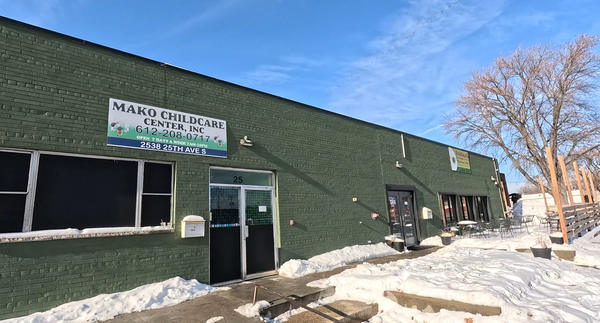
Flaviano Mahecha is using his trusty machete to carve a path through the grassy undergrowth and prickly bushes of a farm on the edge of the Amazon rainforest.
As he approaches a group of palm trees he stops: "This is moriche, and this is acai," he says, pointing excitedly at their leafy crowns.
"Isn't it beautiful? All of Guaviare used to look like this," he adds, referring to the Colombian province that now forms the frontline in a fight to save the Amazon.
A forest of palms spreads out before Mahecha and countless shades of green are juxtaposed against a clear blue sky.
Marking the end of Colombia's vast open plains and the beginning of its dense Amazon rainforest, this farm belongs to Mahecha's friend Victor Vanegas.
It hints at how the entire region looked decades ago, before settlers like Mahecha arrived seeking a better way of life.
This frontier of megadiversity is home to hundreds of species native to the Colombian Amazon, including pink dolphins, tree sloths and red howler monkeys who live alongside indigenous groups.
Yet this rich natural environment is disappearing at an alarming rate.
"In 50 years this could all be a desert," Mahecha, 54, warns solemnly, adjusting his cap for protection from the mid-afternoon sun.
Deforestation has surged but 'there is still time'
Most of this region is legally protected, experts say, yet deforestation has surged in recent years as clearing land for cattle and drug production, as well as development threatens to eliminate essential corridors of biodiversity and a critical buffer zone for the Amazon.
Up to 70 per cent of the deforestation recorded in Colombia in 2018 occurred in regions like Guaviare, where forest loss ballooned 233 per cent between 2016 and 2017.
And forest fires continue to cut charcoal-black scars into the jungle canopy.
Yet there is time, Mahecha believes.
This farm is testament to the potential for change.
Years ago the lot was an empty pasture; today it is being reclaimed once again by the trees and the many living creatures that inhabit them.
"We used to destroy all of this," he says, hugging the smooth trunk of one of the taller acai palms. "But now we've realised we can live off these natural treasures without causing them any harm."
Narco-boom brought brutal violence
A short, stocky, moustachioed man wearing an oversized shirt and baggy trousers, Mahecha is in many ways the quintessential Colombian campesino, or farmer.
And like thousands of others across the region, for many years he saw coca production, the base ingredient of cocaine, as the only way to make a living.
Machecha is more fortunate than many of his friends and family members: he is still alive to recall the height of the narco-boom in the 1990s and 2000s.
The drug trade brought unprecedented riches to the area, but along with it, a brutal wave of violence tore communities apart.
As guerrilla insurgencies, and the paramilitaries established to defend landowners against them, warred over land used for cocaine production, campesinos and their families were often caught in the violence as they toiled for a minute fraction of the price the illegal white powder fetches abroad.
"If you weren't on one side you were on another. No-one would trust you," Mahecha says.
"If you sold coca to the paramilitaries, the guerrillas could come and kill you; if you sold to the guerrillas, the paramilitaries would come for you."
Mahecha pauses intermittently as he struggles to recall the long list of friends and family he lost to the violence: an uncle, a brother-in-law, son-in-law, three cousins, various acquaintances. "Too many," he says.
On one occasion he was nearly killed as he searched for the body of his brother-in-law who had been chopped into pieces by the guerrillas for not paying a bribe.
"We found one part in one place, another part in another. The last thing we found was his head in the bushes," Mahecha recalls.
"But I didn't ask for permission to look for his body, so they stopped me and were going to kill me too. Thank God, they let me go."
A few got rich through the narco-boom, some fled, and many did their best to put up with the vicious cycle of violence.
Swapping cocaine for acai
But for Mahecha, it eventually got too much: the bribes and repeated aerial fumigation of his crops squeezing his profit margin, the constant fear and palpable sense of death, and telling his family face-to-face that he may not see them again every time he left home.
"We were practically burying our children and hoping that our children would not bury us," he says, recalling the days when corpses in the streets became as normal as the brothels that sprung up to serve the drug trade.
Thankfully, he says, it was this realisation that prompted him to sit down with community leaders from across the region and discuss how they could end the cycle of violence and make a living without participating in the coca trade.
After years of meetings and failed experiments, he is delighted to say they found a solution.
"Camu camu, bombona, cocona, acai, moriche, boliche…," Mahecha enthusiastically explains, listing a plethora of Amazonian fruits unknown to most, including most Colombians.
"All these great resources can be harvested without damaging the forest."
An ancient culture delivers a lightbulb moment
The farmers drew inspiration from indigenous groups such as the Nukak Maku, a nomadic tribe displaced from remote depths of the jungle to the peripheries of Guaviare during the conflict in the 1990s.
Contrary to the local dogma that one must first destroy to produce, the farmers watched in awe as the Nukak used wooden blow pipes to shoot down monkeys from high up in the jungle canopy with poisonous darts and scaled the heights of towering trees with their bare hands and feet to pick nutritious berries.
It dawned on them that it was not necessary to chop down vast swathes of forest to raise cattle or cultivate coca; the process was not only killing trees, but exhausting the soil and any chance of one day regenerating the ecosystem that they depend upon.
Why not leave the trees intact and harvest straight from them instead?
Today, 234 families work with the innovative cooperative which Mahecha co-founded and serves as legal representative, the Association of Agricultural Producers for Economic Change of Guaviare, better known by its Spanish acronym, ASOPROCEGUA.
The families pick fruit from the trees and sell it to the cooperative, which then processes it into pulp at a nearby factory and distributes it to hipster restaurants in upscale neighbourhoods in the Andean capital, Bogota.
Thanks to ASOPROCEGUA, 175 families have pledged to zero deforestation, protecting nearly 8,000 hectares of forest, Mahecha says.
The project has become so promising that he recently received invitations to conferences across Europe to share his expertise, much to his humble amusement.
This is how war helped protect the Amazon
But the battle for conservation has not been simple.
While many of the peculiar fruits sold by the cooperative have only recently become trendy for their unusual flavours and "superfood" properties, the world's hunger for cocaine, and thus coca, is rapacious and entrenched.
"It's not easy convincing people to produce products no-one has heard of," Mahecha quips, chuckling.
And not all the locals are as keen on the project as he is.
Guerrilla rebels who still operate in the area finance themselves through drug trafficking and continue to heavily patronise coca production, offering campesinos land and capital to cultivate the drug crop.
The now-defunct Revolutionary Armed Forces of Colombia (FARC), the country's biggest guerrilla insurgency, were once the forest's guardians, imposing strict environmental restrictions to conserve the jungle canopy which obscured them from deadly military planes, and followed their Marxist doctrine.
But they demobilised in 2016 following a historic peace accord with the government.
The groups that have filled their power vacuum do not share such an interest in saving the environment.
As the FARC left the region in 2016, it saw an unprecedented environmental crisis: deforestation surged as forest fires ate into national parks and indigenous reserves.
Hopes that the peace deal would end the conflict and save the environment have proved naive, say local researchers and activists.
Rebels who refused to disarm, and now the de facto authority in some parts, have become key actors in deforestation and are threatening those who get in the way.
"They sent me another one last month," Mahecha says softly in a local cafe, carefully flashing the screenshot of a death threat on his mobile phone, wary of being overheard by the wrong ears. "It hasn't stopped."
Environmentalists are at risk but their job has never been so important
In 2018, 24 environmental activists were killed in Colombia: more than anywhere else in Latin America.
Although the danger is very real, Mahecha says he cannot abandon such a noble cause, particularly during a turning point in history.
Global concern over Australia's bushfires as well as fires in Brazil's Amazon, alongside Greta Thunberg's rise from school child to global celebrity, suggest wider acknowledgement of the "delicacy of the ecosystem".
"If you deforest you aren't only getting rid of the trees, you're getting rid of everything: insects, flora, fauna, medicinal plants, commercial wood, nuts, the roots of the forest," he says. "And not just for you, but for everyone, and all generations."
And there is growing concern among local farmers that deforestation is drying up the region, increasing the temperature, and could eventually reduce the prospect of any agriculture at all.
"I decided to stop cutting down trees so our family and children won't suffer from a lack of water, so they can see nature, and they are protected by it," says Vanegas, who now supplies fruit to ASOPROCEGUA, as he sips sugarcane juice under the shade of a grand oak tree at his farm.
Like most working with the cooperative, Vanegas is quick to boast of the positive impact sustainable farming has delivered, noting how much cooler his farm feels and how many of the animals he saw as a child are returning.
A cultural transformation is underway
Mahecha believes this cultural transformation is key to saving the forest and the solution needs to be grassroots rather than top down.
He wants approaches to the issue overhauled so that poor residents who protect the Amazon are consulted and financially supported for taking on this role in protecting it.
"Farmers will not stop deforestation if they are going hungry," he says. "A person going hungry kills, robs, does all sorts of no good… there needs to be more cooperation on the ground."
In the meantime, he'll keep spreading the word: the wonders of conservation and the perils of choosing short-term profit over long-term prosperity.
"If we don't do it for ourselves we have to do it for our children," he says. "Time is running out."







